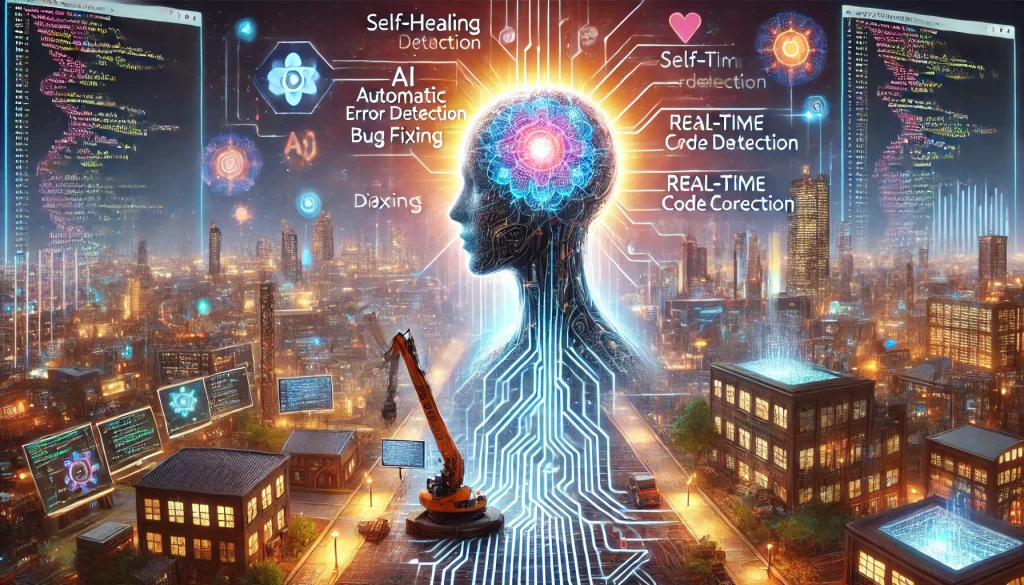Welcome to the globe of self-healing code, a breakthrough in software program development that guarantees to reinvent how we create and maintain efficient software systems. This innovation permits code to autonomously discover and fix mistakes, significantly lowering downtime and improving performance. Developers can focus a lot more on technology and less on debugging, as self-healing code for development automates the error-correction process. This results in durable, reliable software applications that can adapt and improve over time, inevitably resulting in even more durable and reliable systems. Accept the future of coding where maintenance becomes marginal and effectiveness gets to brand-new heights.
- Self-healing code revolutionizes software maintenance, enhancing efficiency and reliability.
- Automated fault detection and recovery streamline software maintenance processes.
- Future of coding: self-healing mechanisms reshape software reliability standards.
What is a Self-healing Code?
Self-healing code describes a software program that can immediately discover, diagnose, and repair its very own issues without human treatment. This capability is inspired by biological systems, which can repair themselves after injury. In software terms, self-healing can entail autonomously correcting bugs, enhancing performance, and maintaining safety. Developers can drastically reduce downtime and improve efficiency by incorporating self-healing code for development. This innovation allows systems to recuperate from real-time mistakes, ensuring constant procedures and reliability. The outcome is extra durable and resilient software, freeing developers to concentrate on brand-new functions and renovations instead of consistent troubleshooting.

The Benefits of Self-healing Code
Self-healing code offers numerous advantages that significantly enhance software development efficiency. Autonomously detecting and correcting issues reduces downtime and maintenance efforts. The following sections delve into these benefits, illustrating how self-healing code improves reliability, real-time response, scalability, and user satisfaction, ultimately leading to more robust and efficient systems.
Improved Reliability and Availability
Self-healing code improves software application reliability and availability by automatically spotting and remedying problems. This constant tracking and intervention reduce the possibility of mistakes and downtime, guaranteeing that applications run efficiently and regularly. Because of this, customers experience continuous service, which enhances satisfaction and trust. For programmers, the reduction in hand-operated troubleshooting allows more focus on development and feature development. By integrating self-healing code for development, companies can preserve high functional performance, satisfying customer expectations and organization demands. This results in more reliable software program systems, boosted customer retention, and a more powerful online reputation for delivering trustworthy, top-notch applications.
Reduced Maintenance Effort
Self-healing code significantly reduces maintenance by automating the detection and correction of software problems. This minimizes the need for manual intervention, allowing developers to focus on creating new features and enhancements rather than constantly fixing bugs. With self-healing code for development, routine maintenance becomes less time-consuming and costly. Automated troubleshooting reduces downtime and ensures more reliable performance over time. This leads to more efficient development cycles, as less time is spent troubleshooting and more time is spent innovating, ultimately leading to higher productivity and better software quality.
Real-time Response
Self-healing code improves real-time responsiveness by detecting and addressing problems as they occur. This proactive approach prevents minor problems from escalating into major failures, maintaining system stability and performance. With self-healing code for development, applications can resolve errors autonomously, ensuring continuous operation and minimal disruption. This immediate response is essential in high-demand environments where delays can lead to significant user dissatisfaction and potential loss of revenue. By maintaining optimal performance and reducing downtime, self-healing code ensures a reliable and efficient user experience, ultimately supporting higher levels of customer satisfaction and operational efficiency.
Scalability
Scalability ensures that software systems can adapt to changing requirements. Self-healing code supports scalability by managing resources and resolving problems on its own. With self-healing code for development, applications can scale efficiently to meet growing demands without compromising performance or reliability. This fosters business growth and innovation by enabling systems to accommodate increased usage and evolving requirements. By leveraging self-healing capabilities, developers can create applications that seamlessly adapt to changing needs, ensuring consistent performance and user satisfaction.
User Satisfaction and Loyalty
User satisfaction and loyalty are essential for any software product. Integrating self-healing code into development can significantly enhance these aspects. When applications address issues autonomously, users experience fewer disruptions. This leads to increased trust and loyalty towards the product. Satisfied users are likelier to remain loyal and recommend the software to others, contributing to business growth. Companies can foster long-term relationships and sustainable success by prioritizing user satisfaction through self-healing code for development.
Software development is not just about writing code; it’s about crafting solutions that empower people and transform industries through innovation and technology.
Sarah Jenkins
Key Components of Self-healing Code
How does self-healing code autonomously detect and resolve issues? We uncover the mechanisms that enable robust and efficient software development by examining its core components—fault detection, diagnosis, decision-making logic, automated recovery, and continuous monitoring. The following sections explain how each component contributes to this process.
Fault Detection
Fault detection is the first step in the process of self-healing code. It continuously monitors the software system to identify anomalies and deviations from expected behavior. By detecting faults early, the system can prevent minor issues from escalating into major problems. Advanced techniques such as anomaly detection algorithms and machine learning models improve accuracy, ensuring that software remains reliable and efficient. The early identification of faults allows for timely intervention, maintaining the overall health of the software and reducing downtime. This proactive approach is essential to creating robust systems capable of managing and resolving problems as they arise.
Diagnosis and Analysis
Diagnosis and analysis follow fault detection in the self-healing code process. This stage involves identifying the root cause of detected anomalies and assessing their impact on the system. Effective diagnostics use comprehensive logging and data analysis to pinpoint problems. By understanding the underlying causes, the system can implement precise corrective actions to minimize disruption. This analysis resolves current faults and provides insights to prevent future occurrences. The use of predictive analytics can further enhance this process, allowing the system to anticipate and mitigate potential problems before they manifest themselves, thus maintaining continuous optimal performance.
Decision-making Logic
Decision logic is central to the effectiveness of self-healing code for development. It includes the algorithms and protocols that determine the appropriate response to detected anomalies. When a problem is detected, the decision logic assesses the severity of the problem and selects the best course of action to resolve it. This could include restarting a service, reallocating resources, or applying a pre-defined fix. By automating these decisions, self-healing code ensures timely and accurate responses, maintaining system stability and performance. The ability to make informed decisions quickly reduces downtime and improves overall software reliability and efficiency.
Automated Recovery
Automated recovery in self-healing code for development ensures that systems can fix problems themselves and maintain continuous operation. When a failure is detected, automated recovery mechanisms immediately apply corrective actions such as restarting services, applying patches, or reallocating resources. This rapid response reduces downtime and maintains system stability. Automating recovery allows developers to focus on innovation rather than constant troubleshooting, resulting in more efficient development cycles. This approach improves software reliability and keeps applications functional and resilient, providing a smooth user experience and maintaining high operational standards without excessive manual intervention.
Monitoring and Learning
Monitoring and learning are integral parts of self-healing code for development. Continuous monitoring allows the system to detect anomalies and track performance in real-time. By analyzing errors and identifying patterns, the system can learn from past incidents, improving its ability to predict and prevent future problems. This continuous learning process increases fault detection and automated recovery accuracy and efficiency. As the system becomes more adept at recognizing and dealing with problems, downtime is reduced, and overall performance is improved. This proactive approach ensures a more reliable and resilient software environment, benefiting developers and users.
Ready to revolutionize your software development with self-healing code?
Contact usReal-World Applications of Self-Healing Code
Embracing self-healing code revolutionizes software program engineering. It settles code review comments autonomously, boosting reliability. Its widespread application extends development and integrity in distributed systems, ingrained systems, and medical devices. This advancement promises to change how we approach coding, boosting reliability and streamlined upkeep.
Resolving code review comments
The use of self-healing code revolutionizes the software development process by automating the resolution of reviewer comments. Google’s innovative model, which uses ML to suggest changes, accelerates coding and resolves issues quickly. This transformative approach ensures adherence to quality standards while freeing developers to focus on more complex tasks. Implementing self-healing code streamlines workflows and increases efficiency throughout the development cycle. This methodology optimizes resources and minimizes manual intervention by autonomously generating changes to correct review feedback. The result is a more agile development environment where iterative improvements occur seamlessly, fostering continuous improvement in software quality. By embracing self-healing code, teams can focus on innovation and creativity, driving progress in software engineering.
Distributed systems and cloud computing
The use of self-healing code holds great promise for improving the reliability and resilience of distributed systems and cloud computing. Such code routinely monitors performance, quickly detects anomalies, identifies error sources, and autonomously implements appropriate remedies. Integrating self-healing mechanisms into development frameworks facilitates automatic problem detection and resolution with minimal human intervention. This evolution cultivates greater robustness in resource optimization and network availability assurance tasks, strengthening interconnected organizations. The judicious use of self-healing mechanisms enables systems to proactively address challenges, improving business continuity and strengthening the foundation for scalable and resilient distributed systems and cloud computing infrastructures.
Embedded systems and medical devices
Implement self-healing code for embedded systems and medical devices to ensure reliability, adaptability, and resilience. This coding paradigm allows these critical components to recover from errors or problems, maintaining uninterrupted functionality autonomously. Moreover, such self-healing mechanisms increase the reliability factor, significantly improving the performance of specialized equipment. This advancement creates a robust operating foundation for embedded systems and medical devices by smoothly resolving failures and malfunctions, which is critical to their seamless integration into medical and industrial applications. Automated error correction capabilities ensure smooth operation and increase the reliability and resilience of these indispensable technologies, contributing to safer and more efficient outcomes.
The Future of Self-Healing Code in Software Development
The future of software development looks promising with the advent of self-healing code. New tools and technologies, such as advances in AI like GPT-4, will enable developers to create resilient and sustainable software systems. This will improve automation processes, making coding more efficient and robust. Self-healing code is likely to become standard in existing frameworks, allowing more developers to use these resources effectively.
However, ethical considerations and workforce implications need to be addressed. User protection is necessary to ensure fairness and accountability in applications where human lives or sensitive data are at stake. In addition, this coding innovation may change the skills required of technical professionals, necessitating adjustments to their training and roles.
Final Words
Self-healing code is a groundbreaking advance in software development, offering significant improvements in reliability, efficiency, and resilience. Developers can focus on innovation rather than constant maintenance by enabling systems to detect and repair problems independently. This shift results in more robust and adaptive software that provides a better user experience.
Ficus Technologies can assist you in integrating self-healing code for development into your systems, ensuring seamless operation and reduced downtime. Our expertise in advanced software solutions will help your business achieve greater efficiency and reliability.
The primary advantage of self-healing code is its ability to autonomously detect, diagnose autonomously, and repair issues within a software system without human intervention. This capability significantly reduces downtime and maintenance efforts, allowing developers to focus more on innovation and new features rather than constant troubleshooting. By continuously monitoring for anomalies and correcting them in real-time, self-healing code enhances the overall reliability and efficiency of software applications. This leads to more robust and resilient systems, ultimately providing a better user experience and reducing operational costs associated with manual maintenance and error resolution.u003cbru003e
Self-healing code cannot completely replace human developers. While it excels at autonomously detecting and fixing issues, thus reducing downtime and maintenance efforts, human developers are essential for designing, innovating, and creating new features. Self-healing code can handle routine troubleshooting and error correction, but it lacks the creativity, critical thinking, and strategic planning abilities that humans bring to software development. Developers are needed to program complex logic, make high-level decisions, and drive the evolution of software systems. Therefore, self-healing code acts as a powerful tool to assist and enhance the work of developers rather than replacing them entirely.








